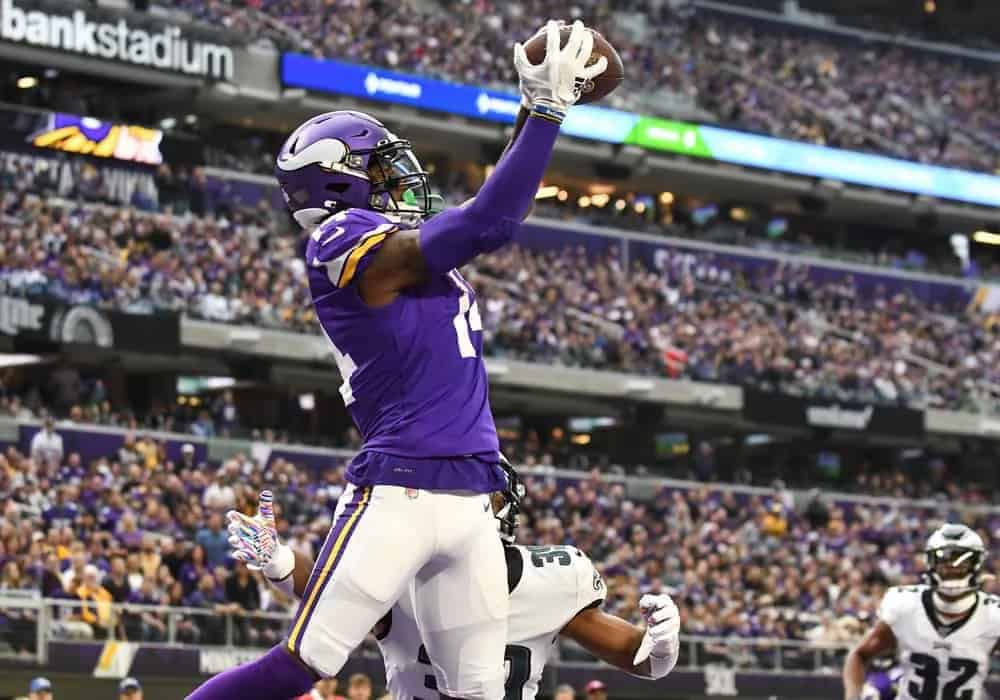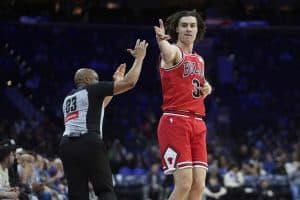We’ve spent enough time talking about the bad of the NFL Draft — biggest quarterback busts this, shocking NFL Draft picks that. How about some positivity? Why don’t we go over some teams that did their research and found those superstars in the later rounds? Or, more accurately perhaps, let’s talk about the players who were the lucky guesses of NFL decision makers (Antonio Brown subtweet). Today we’re going over the biggest NFL Draft steals of all time, which for our purposes started in the year 2000.
Biggest NFL Draft Steals of All Time
Let’s get this out of the way: We’re not including quarterbacks on this list for the simple reason that competent quarterbacks taken in Round 3 or later would take every spot if we were. So yes, Tom Brady is No. 1, Brock Purdy, Kirk Cousins, Dak Prescott and Russell Wilson are all worth mentioning, etc.
One more honorable mention goes to Jason Peters, who doesn’t qualify for the mere fact that he was not drafted and therefore was not a draft steal. But seven All-Pros, including three First-Team appearances, pretty much earmark him for the Hall of Fame and put him on the shortlist of greatest offensive linemen this century.
Geno Atkins, DT, Cincinnati Bengals: Round 4, Pick 120 (2010)
For our token fourth-round pick — there are actually a lot of good players from this round, such as Jared Allen, Eddie Jackson and Asante Samuel — we’re going with the guy who managed to stand out in the most stacked defensive tackle era in league history.
The 2010s saw the primes of Aaron Donald, Fletcher Cox and Ndamukong Suh. All those guys were top-13 picks in their respective drafts. And while Donald was indisputably the best of them all, there is a real argument that Geno Atkins was No. 2.
The Bengals got Atkins in the fourth round primarily because he was small for the position. He measured at just 6-foot-1, and despite high-level athletic metrics like a 4.85 40-yard dash and 34 bench reps, Atkins simply didn’t seem like the physical specimen the interior line demands.
That’s right, Donald even named Atkins as his inspiration. He and Atkins have since changed everyone’s opinion on size for a defensive tackle — Donald is even shorter but has a slightly longer reach — though honestly, the league letting John Randle (6-foot-1, 290 pounds) go undrafted in 1990 should have been the inflection point. Randle and Donald are maybe the starting defensive tackles on the NFL all-time team.
Atkins’ career wasn’t quite to that level, but three All-Pros, eight Pro Bowls and a 2010s All-Decade Team selection have the Hall of Fame squarely in play.
Robert Mathis, DE, Indianapolis Colts: Round 5, Pick 138 (2003)
You can’t really fault the scouts who missed on Robert Mathis. He was a super-duper star in college, setting a record with 20 sacks his senior year, but that came at NCAA I-AA school Alabama A&M. The fact that Mathis showed enough to get drafted is impressive — and doing so as an undersized end at that time (6-foot-2, 240 pounds) is even more impressive.
It didn’t happen right away for him in the NFL, though. Mathis did not start the majority of Colts games until their Super Bowl year in 2006, but he did record double-digit sacks as part of the defensive end rotation in Years 2 and 3. Truthfully, Mathis was mostly viewed as a solid, reliable pass rusher for a decade who was expert at attacking the ball in the quarterback’s hand. He led the league in forced fumbles three times and is the all-time leader in that category. However, he was usually the “other guy” across from Dwight Freeney.
That is, until Freeney went to Atlanta in 2013 and left Mathis to finally be the lead pass rusher. And wouldn’t you know it — Mathis put his stamp on his career by leading the NFL in sacks with 19.5 and finishing second to Luke Kuechly for Defensive Player of the Year. That season, and the crazy fumble numbers, have led to Mathis getting an overwhelmingly positive retrospective assessment, even if in the moment he seemed more “really good” than “all-time great.”
Stefon Diggs, WR, Minnesota Vikings: Round 5, Pick 146 (2015)
Now, the best fifth-round receiver of the last 25 years is undeniably Tyreek Hill, but calling him a “draft steal” is a bit disingenuous. His talent was not really in question; his off-field issues were. They’re well documented, so we don’t need to go into them here, but suffice it to say, getting kicked off the Oklahoma State football team led to Hill projecting to be undrafted. The Chiefs got him in the fifth, he became one of the most explosive players ever, and the rest is history.
Stefon Diggs, on the other hand, fell because of his injury troubles. When Diggs played at Maryland, he was pretty productive, averaging about 80 yards receiving per game. But he missed multiple weekends every year of his college career.
The Vikings took him for his upside in 2015, and though the injuries crept up his first two years, Diggs was more productive in the pros than he ever was at Maryland. He was the Vikings’ WR1 (or WR1A/B, depending on your opinion of Adam Thielen) for three-ish years, made one of the biggest plays in NFL Playoff history and leapt to stardom with the Bills.
Now in Houston, Diggs is showing some signs of slowing, but he has not had a season of fewer than 1,000 yards receiving since 2017.
Richard Sherman, CB, Seattle Seahawks: Round 5, Pick 154 (2011)
What is there to say? Richard Sherman managed to be arguably the face of a Super Bowl winner as a cornerback. The Legion of Boom was the Seattle Seahawks identity, and Sherman embodied that more than anyone.
In case you forgot, this is one of the hardest moments in the history of conference championship games:
So why did Sherman fall to the fifth? Opinions on him varied wildly. He started out as a wide receiver at Stanford but switched to corner in his second-to-last year. He was excellent in that role and had great physical attributes — about 6-foot-3, ran a 4.5 40 and 6.7 three-cone drill — but maybe it was his later-bloomer status? It’s hard to know.
Regardless, some saw him as a second-rounder, some as a sixth-rounder. Alas, he went in the fifth during a run of insane Seahawks draft luck, and now he’s forever a main character on one of the most iconic defenses this century.
Antonio Brown, WR, Pittsburgh Steelers: Round 6, Pick 195 (2010)
We’re going to beat around the bush here. There’s a lot to discuss with Antonio Brown, most of it quite negative (or at least bizarre), but we’ll stick with the Steelers era. That time was mostly positive vibes and uplifting stories of perseverance.
Brown’s productive run at Central Michigan did not impress NFL teams much, and though his combine scores were pretty good and his size wasn’t awful (5-foot-10, 186), Brown slipped to the sixth. Perhaps the lack of touchdowns and middling number of big plays in college did him in.
Well, Brown took that personally; by Year 2 he was a 1,000-yard receiver, and by Year 4 he was on the shortlist of best receivers in the game. Now we’re here, a few years removed from him running off the field mid-game shirtless, and who knows what his Hall of Fame rep is going to be. Seven 1,000-yard seasons, two league leads in both receptions and yards and another for touchdowns, plus five All-Pros on top of that, usually make for an all-timer.
Hey, a draft steal is a draft steal. But golly, did MBC complicate his legacy.
































